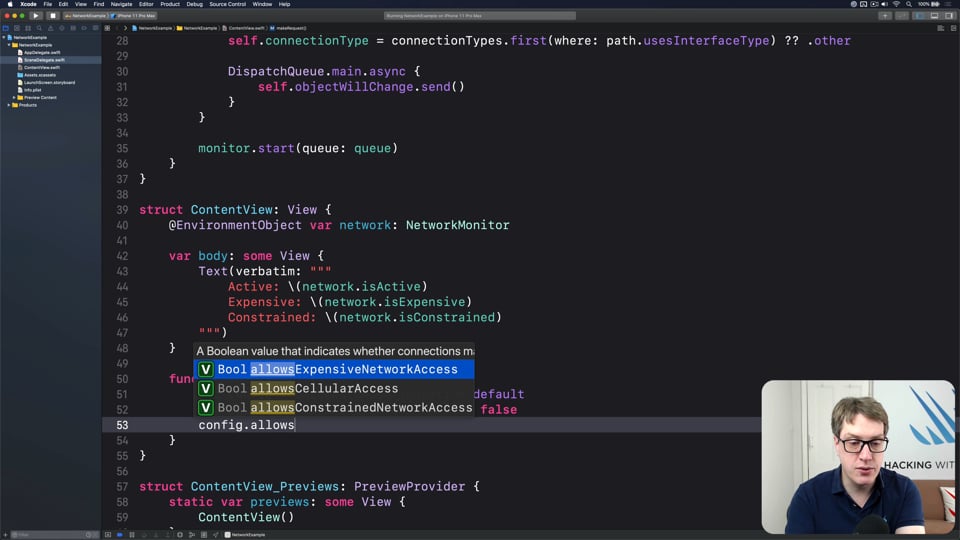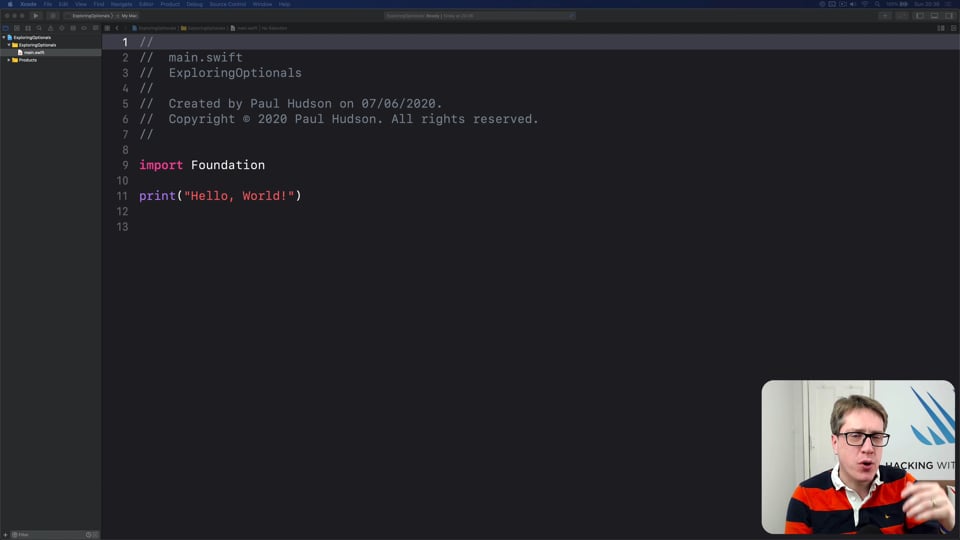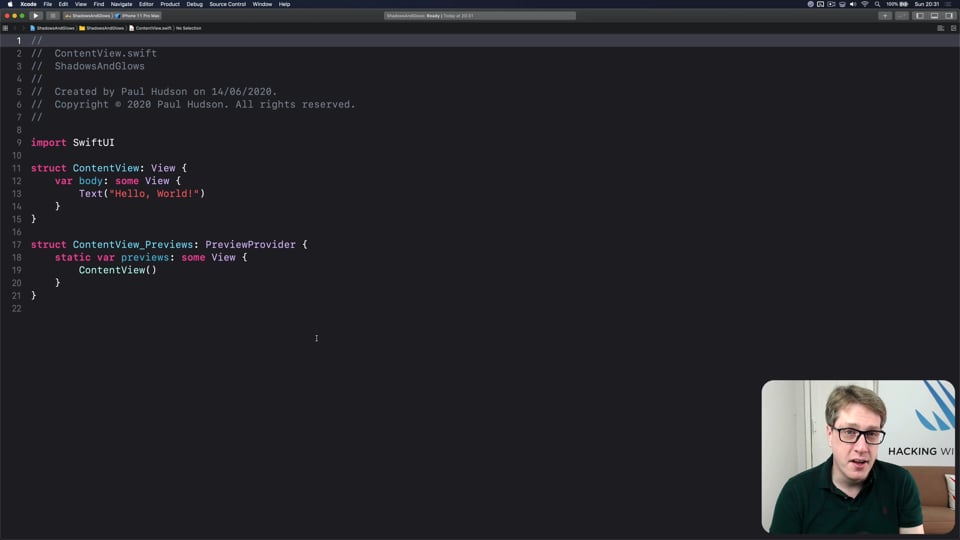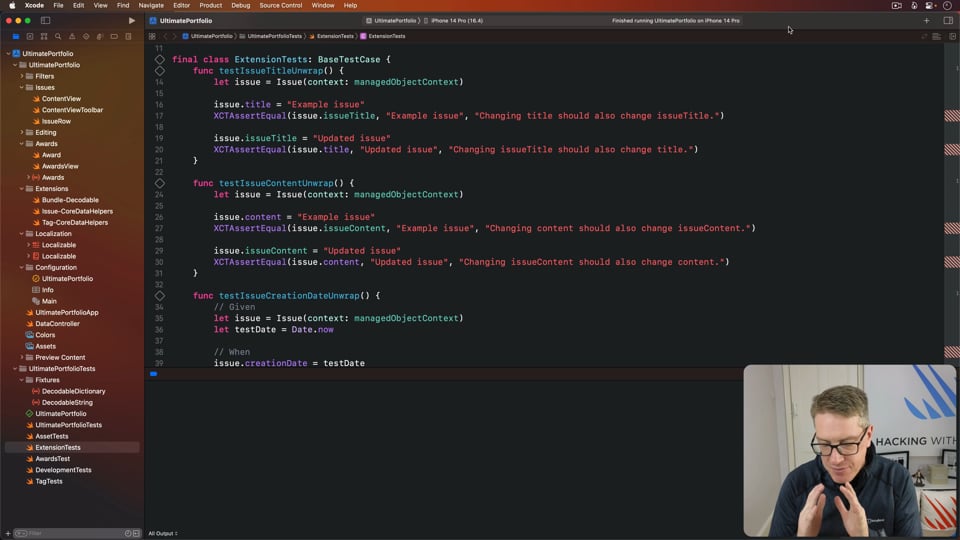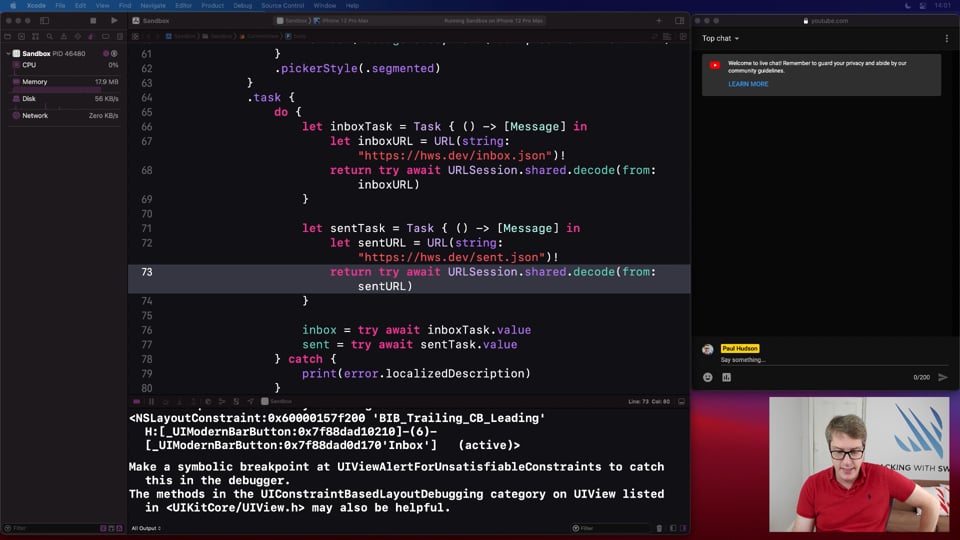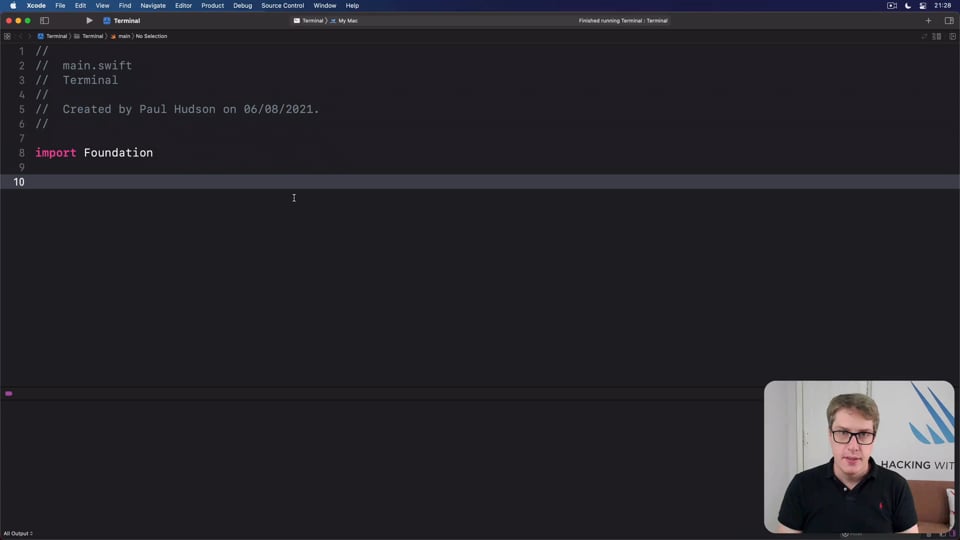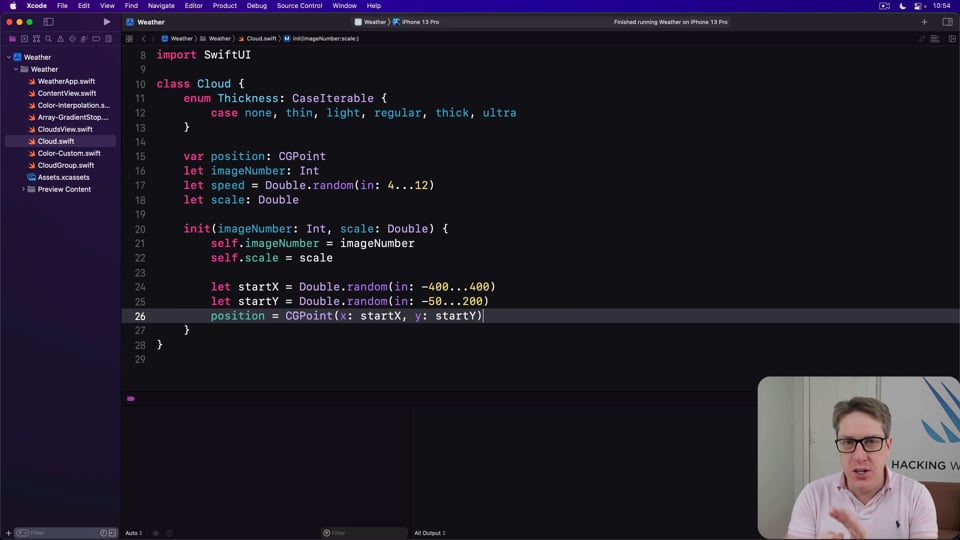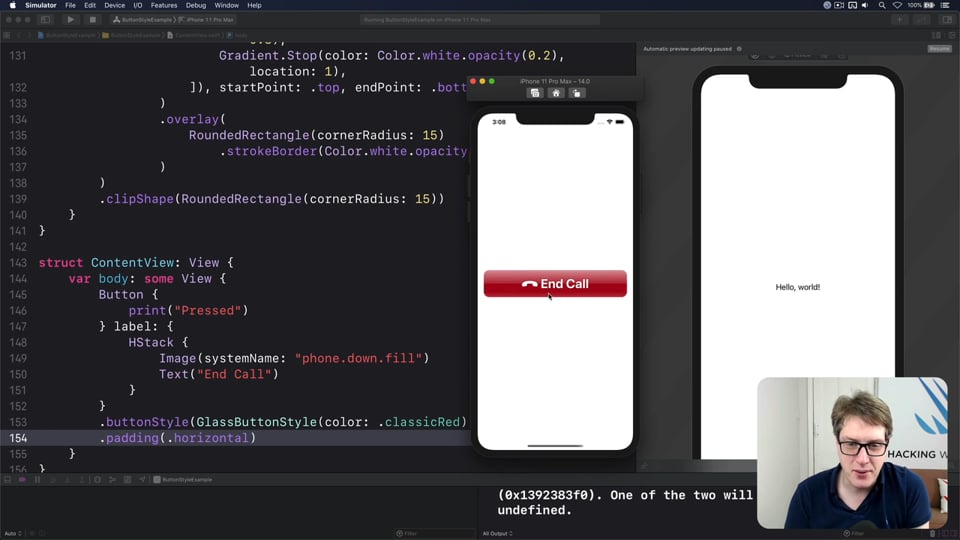How to use phantom types in Swift
Phantom types are a powerful way to give the Swift compiler extra information about our code so that it can stop us from making mistakes. In this article I’m going to explain how they work and why you’d want them, as well as providing lots of hands-on examples you can try.
Watch the video here, or read the article below
Quick links
- What are phantom types?
- What’s the point?
- Hands-on examples
- Building a state machine
- Undefined as a type
- Further reading
- Challenges
What are phantom types?
The basic definition of a phantom type is this: a type that doesn’t use at least one of its generic type parameters. That’s it – it’s not very complicated, at least when looking at the code.
So, this is a phantom type:
struct Employee<Role>: Equatable {
var name: String
}That is generic over some sort of Role, but Role doesn’t appear in the type’s definition – there’s only that one string.
In comparison, here is one of Apple’s Foundation APIs, slightly simplified:
struct Measurement<UnitType> {
let unit: UnitType
var value: Double
}That is not a phantom type, no matter what you might hear elsewhere – it is generic over UnitType but that parameter is used right there for unit, so this is just a regular generic type.
So, the definition of a phantom type is simple, but the real question here is this: why the heck would you want to specify a generic parameter and never use it?
What’s the point?
Our trivial phantom type was this:
struct Employee<Role>: Equatable {
var name: String
}That doesn’t use Role at all, so we could just have used this instead:
struct Employee: Equatable {
var name: String
}However, there’s an important difference: although we don’t use the generic parameter, Swift does. This allows Swift to enforce rules for us much more strictly.
For example, if you work for a software company you might have employees who work in a coding team and other employees who work in a sales team. We can represent them with no-case enums like these:
enum Sales { }
enum Programmer { }Tip: It’s a good idea to use a no-case enum rather than a struct, because the enum cannot be instantiated, whereas someone could create an instance of the struct and wonder what it’s good for.
Now, if you had a friend called Zoe who worked in the coding team, she might look like this:
let zoe1 = Employee<Programmer>(name: "Zoe")And if you had another friend called Zoe who worked in the sales team, she might look like this:
let zoe2 = Employee<Sales>(name: "Zoe")Now, we made Employee conform to Equatable, and because its single property already conforms to Equatable Swift will be able to synthesize an == function to let us compare two employees. So, we can check whether our two employees are actually the same person like this:
print(zoe1 == zoe2)Except that won’t work – we aren’t comparing two instances of Employee any more, we’re comparing an Employee<Programmer> and an Employee<Sales>, and Swift considers them to be different. In comparison, if we had made someone’s role a string property, Swift would say that the two Zoe’s are different at runtime, but it wouldn’t stop us from compiling.
That’s the power of phantom types: we give Swift extra information that clarify how things should work, and allow it to work harder on our behalf. When done well, this will allow logic errors to be surfaced as compiler errors: Swift literally won’t build our code because what we’re trying to do doesn’t make sense.
Hands-on examples
If you were working in a hospital that analyzes blood samples, you might start by defining some of the different blood types:
enum OPositive { }
enum APositive { }
enum BPositive { }Now you can create a BloodSample struct that is generic over some sort of blood type, like this:
struct BloodSample<Type> {
let amount: Double
static func +(lhs: BloodSample, rhs: BloodSample) -> BloodSample {
BloodSample(amount: lhs.amount + rhs.amount)
}
}That has a + operator that lets us combine two blood samples, but Swift will automatically understand that two samples from different blood types are different and stop us from mixing them by accident.
So, this code will work:
let sample1 = BloodSample<OPositive>(amount: 5)
let sample2 = BloodSample<APositive>(amount: 5)
let sample3 = BloodSample<OPositive>(amount: 7)
let combined1 = sample1 + sample3But this will not:
let combined2 = sample1 + sample2Sometimes the differences between types are less subtle. For example, consider a user struct like this one:
struct User {
let id: Int
let age: Int
}Both id and age are integers, so there’s nothing stopping us from comparing them like this
let user = User(id: 53, age: 53)
print(user.id == user.age)I mean, yes, the two integers are identical, but if you’re comparing user IDs to ages then it’s almost certainly a mistake – and it’s a mistake phantom types can help us catch.
First, we make no-case enums to represent out variations:
enum UserID { }
enum Age { }Next, we create a struct that is generic over some kind of type, but doesn’t actually use that type in its definition:
struct Tag<Type>: Equatable {
var value: Int
}Now we can modify the User struct so that each of its properties use Tag, like this:
struct User {
let id: Tag<UserID>
let age: Tag<Age>
init(id: Int, age: Int) {
self.id = Tag(value: id)
self.age = Tag(value: age)
}
}And now trying to compare id and age simply won’t work.
In practice, I’d prefer to change that a little so that Tag conformed to the ExpressibleByIntegerLiteral protocol like this:
struct Tag<Type>: Equatable, ExpressibleByIntegerLiteral {
init(integerLiteral value: Int) {
self.value = value
}
var value: Int
}That allows Swift to make instances of Tag directly from an integer, so we can simplify all the types that use Tag so they rely on Swift’s synthesized memberwise initializer:
struct User {
let id: Tag<UserID>
let age: Tag<Age>
}For a broader solution to this same problem, see my article Improving your Swift code using value objects.
The most important thing to remember is that although our phantom types are empty, the Swift compiler is fully aware of them. So, you can use them as constraints in extensions and more – they aren’t special.
Building a state machine
There are lots of practical ways you can use phantom types to build interesting stuff, and I came across one fascinating experiment from Soroush Khanlou. In his example, Soroush uses phantom types to build a state machine where invalid transitions can’t compile – Swift won’t allow it.
Tip: State machines are pieces of code that are designed to move between a series of predefined states. For example, a vending machine might move between the states “waiting for customer”, “coin inserted”, “fetching selection” and “serving selection”. It wouldn’t make sense for the vending machine to go from “waiting for customer” to “serving selection”, because no coin was inserted.
Soroush very kindly gave me permission to use his code here, although I’m going to simplify a little so we can focus on the part that matters.
First, we create the various states our machine can be in. For this example we’ll have have the four that represent a vending machine:
enum Waiting {}
enum CoinInserted {}
enum Fetching {}
enum Serving {}Second, we create a phantom type to store a transition between two states:
struct Transition<From, To> {}Neither of those types are used – the struct is literally empty. But that’s okay, because Swift is still able to track them.
Third, we’ll create a Machine struct that represents our state machine in one given state. This has one method that will transition from the current state to a new state, like this:
struct Machine<State> {
func transition<To>(with transition: Transition<State, To>) -> Machine<To> {
.init()
}
}That’s doing a lot of work in hardly any code, so let’s break it down:
- The
Machinestruct is generic over some kind ofState. - The
transition()method is generic over some kind ofTo, but also relies on theStategeneric parameter fromMachine. - We’re telling Swift the transition must be from the current state of our machine, and to some other kind of state.
- The function returns a new machine that uses the new
Tostate. - Using
.init()will automatically make a newMachinestruct of the correct type:Machine<To>.
Now we can go ahead and create all valid transitions by specifying where they come from and where they go to, like this:
let start = Transition<Waiting, CoinInserted>()
let selectionMade = Transition<CoinInserted, Fetching>()
let delivery = Transition<Fetching, Serving>()
let reset = Transition<Serving, Waiting>()And that’s it! We can now create a Machine with a particular state, and step it through any other possible valid state, like this:
let m1 = Machine<Waiting>()
let m2 = m1.transition(with: start)
let m3 = m2.transition(with: selectionMade)
let m4 = m3.transition(with: delivery)
let m5 = m4.transition(with: reset)The magic here is that Swift will check all those transitions at compile time – it’s not possible to make an illegal transition.
For example, this won’t compile:
let m6 = m5.transition(with: delivery)The problem is that m5 is a Machine<Waiting>, so we can’t go straight from there to a Machine<Serving>.
I think this is a fantastic experiment, because it shows how we can leverage the Swift compiler to prove that our code is correct. Plus, it makes for a fascinating exploration of phantom types in action.
However, in practice this solution doesn’t work so well. To explain why, I asked Soroush himself – here’s what he said:
“I originally wrote this as an experiment to see if I could have the compiler protect me from performing invalid transitions on a state machine, but I quickly realized that changes to the state would cause the type of the entire machine to change, meaning that it couldn’t be stored back into the same variable. This prevents you from having it as a property on, say, a view controller, with transitions modifying the state machine. So: fun to try out, a little impractical in actual usage.”
Undefined as a type
Before I finish, there’s one more technique I want to demonstrate, and it’s quite different from all the earlier examples. It’s this piece of code:
func undefined<T>(_ message: String = "") -> T {
fatalError("Undefined: \(message)")
}That isn’t a phantom type, but it is a great example of using Swift’s type system in interesting ways. I first saw this being used by Johannes Weiss from the SwiftNIO team, where he presented this as a useful global function to have around while you’re still building your app.
This function, undefined<T>(), can act as pretty much any other kind of value you want, because it is generic over T and promises to return a T. It won’t actually return a T, but it doesn’t need to: calling fatalError() is enough to see that nothing needs to be returned.
This set up it can act as a placeholder to make your code compile when you’re part-way through your work and don’t want to fill in all the various parts just yet.
You can make simple instances of types using undefined(), like this:
let name: String = undefined("Example string")
let score: Int = undefined("Example int")You can make it act as a placeholder inside a function you haven’t written yet:
func userID(for username: String) -> Int? {
undefined(username)
}In that instance you could use fatalError() to mark the missing code, but then again fatalError() does have legitimate uses outside of marking unfinished work so it becomes harder to find and replace later.
And you can even use it repeatedly when there are lots of parameters you haven’t filled in yet:
let timer = Timer(timeInterval: undefined(), target: undefined(), selector: undefined(), userInfo: undefined(), repeats: undefined())Obviously many of these places could be replaced with hard-coded placeholders, such as 0 or an empty string, but the magic of undefined() is that it will crash as soon as it’s touched – it will work only at compile time, to help you move your project forward, but can’t possibly work at runtime. Also, it’s easier to search your code for “undefined” than some magic value!
Of course, you might have the question “if undefined<T>() isn’t a phantom type, what is it?” And to be honest I had exactly the same question, so I went back to the source and asked Johannes. Here’s what he said:
I wouldn't call
undefined<T>()a phantom type because first of all, really it's a value. Well, a value that we'll never generate, but still. Even callingTa phantom type isn't quite right:Tcan be anything, so it could be aStringwhich is far from a phantom type. I think the closest somewhat correct term I have for this is that it's called the "bottom value", usually written like ⏊, and even that is probably not right because the "bottom type" is defined as not having values! So the term "bottom value" isn't great either, but I guess we could say "undefined's return type is bottom"?
I love that answer, because it shows just how nuanced the discussion is.
Anyway, that finishes up our discussion about phantom types. You’ve seen how they work and I’ve given you some hands-on examples, plus I’ve walked you through how we can build state machines using them as an interesting experiment, and even how we can create simple placeholder functions that can act as helpers to make our code compile while we’re still working. They might not be phantom types, but they are still fascinating!
Further reading
Phantom types are a fascinating area of discussion, and there’s a lot of high-quality material I recommend you check out.
First, Johannes Weiss delivered the talk that originally introduced to me to phantom types in Swift: The Type System is Your Friend. He also introduced the undefined() function there, although I recommend you check out his repository on GitHub because it’s a little more advanced.
Second, Brandon Case delivered a talk called Strings Are Evil, where he builds a file-handling system where phantom types make it impossible to created badly-formed file paths.
Third, if the idea of tagged integers interested you, you might want to check out the Tagged repository on GitHub, which takes the concept significantly further. As an alternative, you should check out my article Improving your Swift code using value objects.
Fourth, I walked you through a simplified version of Soroush Khanlou’s state machine, but if you’d like to read the full version it’s in this GitHub Gist
Finally, Ole Begemann walks through what it would look like to rewrite Apple’s Measurement API using phantom types in this article: Measurements and Units with Phantom Types
Challenges
If you’d like to take your knowledge of phantom types further, try creating phantom types to solve these problems:
- A
Temperaturetype that is generic over whether it uses Celsius or Fahrenheit. - A
Cartype that is generic over whether it uses diesel or gas for the engine.
I also have a question that I’d like you to consider: what benefits of phantom types could we gain by using a class hierarchy instead? Just as importantly, what benefits would we lose?
If you liked this, you'd love Hacking with Swift+…
Here's just a sample of the other tutorials, with each one coming as an article to read and as a 4K Ultra HD video.
Find out more and subscribe here
NETWORKING
FREE: User-friendly network access
Anyone can write Swift code to fetch network data, but much harder is knowing how to write code to do it respectfully. In this article we’ll look at building a considerate network stack, taking into account the user’s connection, preferences, and more.
ADVANCED SWIFT
FREE: Making the most of optionals
Swift’s optionals are implemented as simple enums, with just a little compiler magic sprinkled around as syntactic sugar. However, they do much more than people realize, and in this article I’m going to demonstrate some of their power features that can really help you write better code – and blow your mind along the way.
FUNCTIONAL PROGRAMMING
FREE: Functional programming in Swift: Introduction
Before you dive in to the first article in this course, I want to give you a brief overview of our goals, how the content is structured, as well as a rough idea of what you can expect to find.
INTERVIEW QUESTIONS
FREE: Interview questions: Introduction
Getting ready for a job interview is tough work, so I’ve prepared a whole bunch of common questions and answers to help give you a jump start. But before you get into them, let me explain the plan in more detail…
HIGH-PERFORMANCE APPS
FREE: Using memoization to speed up slow functions
In this article you’ll learn how memoization can dramatically boost the performance of slow functions, and how easy Swift makes it thanks to its generics and closures.
DATA STRUCTURES
FREE: Trees
Trees are an extraordinarily simple, extraordinarily useful data type, and in this article we’ll make a complete tree data type using Swift in just a few minutes. But rather than just stop there, we’re going to do something quite beautiful that I hope will blow your mind while teaching you something useful.
INTERMEDIATE SWIFTUI
FREE: Creating a custom property wrapper using DynamicProperty
It’s not hard to make a basic property wrapper, but if you want one that automatically updates the body property like @State you need to do some extra work. In this article I’ll show you exactly how it’s done, as we build a property wrapper capable of reading and writing documents from our app’s container.
FUNCTIONAL PROGRAMMING
FREE: Transforming data with map()
In this article we’re going to look at the map() function, which transforms one thing into another thing. Along the way we’ll also be exploring some core concepts of functional programming, so if you read no other articles in this course at least read this one!
ULTIMATE PORTFOLIO APP
FREE: Ultimate Portfolio App: Introduction
UPDATED: While I’m sure you’re keen to get started programming immediately, please give me a few minutes to outline the goals of this course and explain why it’s different from other courses I’ve written.
CUSTOM SWIFTUI COMPONENTS
FREE: Creating a WaveView to draw smooth waveforms
In this article I’m going to walk you through building a WaveView with SwiftUI, allowing us to create beautiful waveform-like effects to bring your user interface to life.
SWIFTUI SPECIAL EFFECTS
FREE: Shadows and glows
SwiftUI gives us a modifier to make simple shadows, but if you want something more advanced such as inner shadows or glows, you need to do extra work. In this article I’ll show you how to get both those effects and more in a customizable, flexible way.
INTERMEDIATE SWIFT
FREE: Understanding generics – part 1
Generics are one of the most powerful features of Swift, allowing us to write code once and reuse it in many ways. In this article we’ll explore how they work, why adding constraints actually helps us write more code, and how generics help solve one of the biggest problems in Swift.
INTERMEDIATE SWIFT
FREE: Understanding assertions
Assertions allow us to have Swift silently check the state of our program at runtime, but if you want to get them right you need to understand some intricacies. In this article I’ll walk you through the five ways we can make assertions in Swift, and provide clear advice on which to use and when.
ULTIMATE PORTFOLIO APP
Measuring performance
UPDATED: Although our project doesn’t do anything particularly performance intensive, having a great portfolio app means you should at least attempt to demonstrate you understand how performance tests work. In this chapter we’ll add just such a test to our project, to make sure our award counting work is fast.
EVENTS
Advanced tasks
One of the big advantages to tasks is that we can pause them, or cancel them outright if their work is longer needed. Even better, for bigger problems we can create whole groups of tasks to accomplish work together.
INTERVIEW QUESTIONS
What is UserDefaults good for? What is UserDefaults not good for?
UserDefaults is the simplest way of storing user data, which makes it appealing for beginners, but also useful for even experienced developers who need a sensible place to stash away user preferences. However, it has downsides, and it’s important you’re familiar with them if you want to answer this question well.
INTERVIEW QUESTIONS
What does the final keyword do, and why would you want to use it?
This is crying out for an example, so once you get the basic answer out of the way back it up with some actual code example where final is the right choice.
FUNCTIONAL PROGRAMMING
Applying a predicate with contains() and filter()
In this article we’re going to look at the contains() and filter() functions, which search a sequence to see whether a certain test passes. Along the way you’ll see how similar these two functions are, along with how to build them yourself.
REMAKING APPS
Drawing a star field
At night the weather app usually shows stars, although if you live in my town chances are they are usually obscured by clouds! These stars aren’t as simple as you might think, so we need to get a bit creative…
INTERMEDIATE SWIFTUI
Basic button customization using ButtonStyle
SwiftUI’s humble Button view is actually capable of doing remarkable things if you take the time to customize it. In this video I’ll be walking you through the ButtonStyle protocol, showing you how we can use it to make great-looking and reusable button effects.
